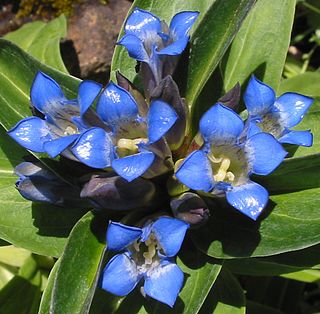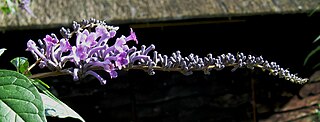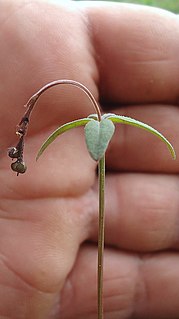
Gentianales is an order of flowering plants, included within the asterid clade of eudicots. It comprises more than 16,000 species in about 1,138 genera in 5 families. More than 80% of the species in this order belong to the family Rubiaceae.

Buddleja is a genus comprising over 140 species of flowering plants endemic to Asia, Africa, and the Americas. The generic name bestowed by Linnaeus posthumously honoured the Reverend Adam Buddle (1662–1715), an English botanist and rector, at the suggestion of Dr. William Houstoun. Houstoun sent the first plants to become known to science as buddleja to England from the Caribbean about 15 years after Buddle's death.

Anthocleista is a genus of tree- and shrub-like tropical plants in the gentian family, tribe Potalieae, subtribe Potaliinae. There are about 50 species in the genus, native mainly to tropical Africa, including Madagascar and the Mascarene Islands. Anthocleista was once placed in the family Loganiaceae, but more recent molecular, morphological, and phytochemical evidence has placed the group well within the Gentianaceae.

The Loganiaceae are a family of flowering plants classified in order Gentianales. The family includes up to 13 genera, distributed around the world's tropics. There are not any great morphological characteristics to distinguish these taxa from others in the order Gentianales.

Strychnos is a genus of flowering plants, belonging to the family Loganiaceae. The genus includes about 100 accepted species of trees and lianas, and more than 200 that are as yet unresolved. The genus is widely distributed around the world's tropics and is noted for the presence of poisonous indole alkaloids in the roots, stems and leaves of various species. Among these alkaloids are the well-known and virulent poisons strychnine and curare.
Usteria is a plant genus in the family Loganiaceae. It was established in 1790 by Carl Ludwig Willdenow.

Buddleja davidii, also called summer lilac, butterfly-bush, or orange eye, is a species of flowering plant in the family Scrophulariaceae, native to Sichuan and Hubei provinces in central China, and also Japan. It is widely used as an ornamental plant, and many named varieties are in cultivation. The genus was named Buddleja after Reverend Adam Buddle, an English botanist. The species name davidii honors the French missionary and explorer in China, Father Armand David, who was the first European to report the shrub. It was found near Ichang by Dr Augustine Henry about 1887 and sent to St Petersburg. Another botanist-missionary in China, Jean-André Soulié, sent seed to the French nursery Vilmorin, and B. davidii entered commerce in the 1890s.

Jeffersonia, also known as twinleaf or rheumatism root, is a small genus of herbaceous perennial plants in the family Berberidaceae. They are uncommon spring wildflowers and grow in limestone soils of rich deciduous forests. Jeffersonia was named for United States President Thomas Jefferson by his contemporary Benjamin Smith Barton. This genus was formerly grouped in genus Podophyllum. Twinleaf is protected by state laws as a threatened or endangered plant in Georgia, Iowa, New York, and New Jersey.

Geniostoma is a genus of around 25 species of flowering plants in the family Loganiaceae. They are shrubs or small trees, with inflorescences borne in the axils of the simple, petiolate, oppositely-arranged leaves. The flowers are arranged in cymes, and each is pentamerous.

Buddleja colvilei is endemic to the eastern Himalaya; discovered by Hooker in 1849, he declared it 'the handsomest of all Himalayan shrubs.' In 1896 the species was awarded the RHS First Class Certificate (FCC), given to plants 'of outstanding excellence for exhibition'.
Mitreola is a genus of fossil sea snails, marine gastropod mollusks in the family Volutidae, the volutes.

Buddleja lindleyana is a deciduous shrub native to the provinces of Anhwei, Hunan, Hupeh, Kiangsu, Shanghai, Sichuan, and Yunnan in China, where it grows in rocky scrub alongside streams and tracks at elevations of 200 – 2700 m. The shrub has also naturalized on Okinawa-jima, Japan, and in the south-eastern states of the United States.

Spigelia genuflexa is a species of annual herb of the family Loganiaceae from Bahia state, Brazil, which was described in 2011. It is unusual in that the stems bend down after flowering to deposit the seeds in the soil (geocarpy).
Anthonius Josephus Maria "Toon" Leeuwenberg was a Dutch botanist and taxonomist best known for his research into the genus Buddleja at the Laboratory of Plant Taxonomy and Plant Geography, Wageningen. He was responsible for sinking many Asiatic species as varieties, notably within Buddleja crispa. In 1962, he worked with Jan de Wilde on the flora of the Ivory Coast.

Polypremum is a flowering plant genus in the family Tetrachondraceae. The genus contains the single species Polypremum procumbens, commonly known as juniperleaf or rustweed. Polypremum has also been placed in the various families Buddlejaceae, Loganiaceae, Rubiaceae, and most recently in its own Polypremaceae.
Sanango is a genus of flowering plants containing a single species, Sanango racemosum. The genus was originally placed in family Loganiaceae but has since been variously placed in Scrophulariaceae, Gesneriaceae and Buddlejaceae. As of 2016 it is considered to be the sister genus to the family Gesneriaceae as previously defined, and the family was tentatively enlarge to include the genus, pending a revision of the families included in Lamiales.

Mitreola sessilifolia, commonly known as swamp hornpod, is a species of small flowering plant in the genus Mitreola in the family Loganiaceae. The plant is native to the southeastern United States, but can be found as far west as Arizona. It was previously included in the genus Cynoctonum.It is also considered a facultative wetland species (FACW), which makes it an indicator species for wetlands, but may occur in non-wetland areas as well.
Mitreola is the name of two genera of organisms and may refer to:
Adelphacme is a genus of flowering plants belonging to the family Loganiaceae.













